
As an alternative to surgery, the platelet-rich plasma injection is getting attention for its ability to help the body use its own healing properties to treat muscle, tendon and ligament injuries.
During a PRP injection procedure, the doctor harvests platelets from the patient, then concentrates them in the patient’s own plasma before injecting them into an injury to promote healing.
“We most often use PRP injections in tendon injuries,” said Ryan Modlinski, M.D., orthopedic sports medicine specialist with Norton Sports Health. “Tendon injuries have somewhat poor blood flow, which tends to mean poor healing. The PRP injections ensure ample amounts of platelets are reaching the wounded area, enhancing the healing process.”
PRP injections begin with a quick blood draw. Then, that blood is run through a centrifuge, which is a machine that rapidly spins, separating the parts.
“We get rid of the white blood cells, the red blood cells, the plasma and, basically, isolate only the platelets,” Dr. Modlinski said.
A second set of rotations in the centrifuge brings the platelets to 10 times their original concentration, hence the term platelet-rich plasma.
The physician then has a window of about 30 to 60 minutes to inject the platelet-rich plasma. An ultrasound is used to pinpoint the targeted tissue.
The injection triggers an inflammatory healing response, so the patient can expect to feel some soreness afterward.
“They will feel a little worse the next day,” Dr. Modlinski said. “I tell them that for the next three days it will feel like you pulled a muscle or re-injured yourself, then it will start feeling better.”
When the procedure is finished, the patient should rest the treated joint so the platelets can do their job in healing the tissue. Some patients use an arm brace or crutches to help avoid joint movement.
PRP injections don’t involve a hospital stay.
Norton Sports Health physicians typically use PRP injections on small tears and chronic strains. Some of the most common tendon injuries Dr. Modlinski has treated with PRP injections are Achilles tendon and patella injuries, as well as tennis elbow and rotator cuff injuries.
PRP injections also can help with arthritis, specifically in the knee.
“Recent research has shown some positive outcomes for knee osteoarthritis,” Dr. Modlinski said. “The injections were found to reduce pain for upward of six months to a year.”
If you have a patient with a large tendon injury, PRP injections are not the ideal treatment. Dr. Modlinski suggests it would be better to restore function to that tissue with surgery.
Refer a patient
To refer a patient to Dr. Modlinski or any Norton Sports Health provider, click here for the online referral form or call (502) 559-5500.

